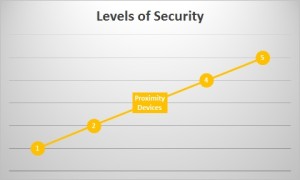Welcome to the third installment in our series on Levels of Security! In this series we will be investigating how different ID solutions fit different security needs. As we advise organizations on appropriate badge solutions, we find their needs fall into one of five levels of security. We’ve categorized these by the appropriate solutions: printed PVC cards, barcode & magnetic stripe cards, proximity access devices, contact and contactless RFID cards, and biometric authentication.
 Clients whose facilities need a moderate degree of security may find their best solution in proximity access devices. Organizations issue these devices, which take the form of cards, key-fobs, or stick-on (adhesive) disks, to individual users. Each device includes a tiny computer chip that houses a small amount of data custom-programmed for a facility. These credentials allow an installed access control system to determine if the device holder has the required permission to access a facility.
Clients whose facilities need a moderate degree of security may find their best solution in proximity access devices. Organizations issue these devices, which take the form of cards, key-fobs, or stick-on (adhesive) disks, to individual users. Each device includes a tiny computer chip that houses a small amount of data custom-programmed for a facility. These credentials allow an installed access control system to determine if the device holder has the required permission to access a facility.
Prior to the introduction of access-control systems, organizations would provide key copies to their employees, or have full-time receptionists, or employee security guards as ways to manage access.
Benefits of Using Proximity Access Devices
- Unlike keys, access control systems can operate on schedules. For example, a key-card or fob can allow access to buildings only Monday thru Friday from 8:00am to 6:00pm. Other devices and individuals can have their own unique schedules.
- Also unlike keys, with proximity access devices, you can immediately and remotely “turn off” or modify access areas and times. This means that if an organization needs to change an individual’s access, it can do so quickly, without affecting any other device holder. This includes restricting access to certain facilities or to certain days or times. In the “old days”, if an employee’s access need to be changed, locks were changed and new keys issued. As you can imagine, this was a considerable expense!
- If the proximity access device is a printable ISO card, it can double as the employee’s photo ID. This provides both a visual identity check and a physical access-control check, further enhancing security.
- Proximity access device readers can work with optional modules, such as numeric key-pads, requiring input of a second-form of authentication. Often used on exterior doors, these combinations help to prevent unauthorized entry should someone find a lost credential.
As technology has developed, more secure options have been introduced which can store more data and are more difficult to be scanned and copied. We will explore those options in coming installments. But, for organizations with a need for flexible security controls, while maintaining relatively low or moderate costs, the access-control systems and proximity devices are the perfect solution.
